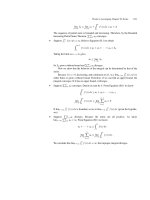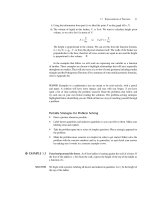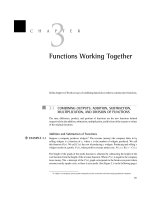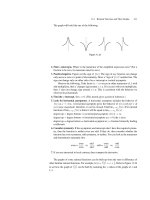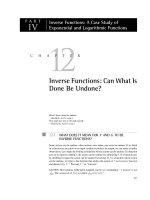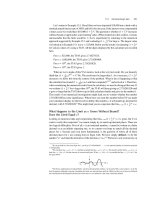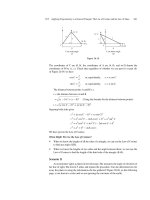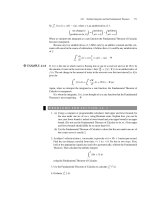30 DAYS TO BETTER SIGHT A LIFETIME OF CRYSTAL CLEAR VISION - PART 5 pdf
Bạn đang xem bản rút gọn của tài liệu. Xem và tải ngay bản đầy đủ của tài liệu tại đây (50.8 KB, 13 trang )
The Energy Explanation
In addition to this calming effect, many believe that during palming, healing energy
passes through the palms of your hands into your eyes.
If you’re a sensitive person, and you relax and concentrate a little, you’ll actually be
able to feel this happening, and you can even magnify the effect by using your
tention or imagination. You’ll find you can ‘pull’ energy from your hands with your
feel expansive and magnetic!
energy, once you begin to identify it. Then,
your palming sessions will become an exciting adventure, rather than just some
doesn’t really matter which or these explanations are true, or perhaps all of them
ore than that… this could be THE SINGLE MOST IMPORTANT EXERCISE TO
t clear enough?
ness
is the key here. While palming, you really need to "let go", both
entally and physically. Your eyes cannot completely relax when your mind or
reathe slowly, evenly and naturally. Don’t force your breath. Let it come and
o. Let your lungs fill up, and then let them empty. No effort.
in
eyes, or you can intentionally send healing energy from your hands into your eyes.
Sometimes, this energy feels warm and soothing, sometimes it feels a little cool
and prickly, sometimes it
Actually, it’s a lot of fun to play with this
exercise that you’re doing to see better!
It
are. The fact is PALMING WORKS.
M
HELP YOU GET YOUR SIGHT BACK!
Ok, is tha
Tips and Techniques to Improve your Palming Effective
Relaxation
m
body is full of stress and tension.
B
g
Visualize Black Velvet! Even though your hands are blocking out the light, you
s to
’ (remember that open mind we talked
using your intention and imagination to
xed position. You can do Palming with your elbows on your thighs or
our 15 minute routine, EVERY DAY. You should
palm for at least 5 of the 15 minutes.
Once you start doing this, and noticing the benefits, you’ll want to do it more, so
, palming won’t tire your eyes and muscles, so
can make the exercise more effective by visualizing the color black. Most people
find this easiest by imagining something black, for example a very dark box, lined
with black velvet.
The ‘darker’ the black you can ‘see’, the quicker your eyesight improvement!
Rub your hands together. Before you start your palming, rub your hands together
for 10-20 seconds very vigorously. This is a technique used by energy healer
bring healing energy into the hands, which you can then pass into the eyes.
If you don’t believe in ‘healing energy
about?), then just see it as getting some heat into the hands, which feels nice on
the eyes and helps them relax more.
You can make this even more effective, by
send healing energy to your hands when you rub them together.
Find a rela
on a table. You can also place a cushion under your elbows for both positions.
Supporting your elbows helps you relax a little more.
Practice palming as part of y
start to get into the habit of palming many times during the day, whenever you
have a few spare moments.
Unlike some of the eye exercises
you aren’t going to overdo it. You can palm for hours each day if you really want, it
won’t harm your eyes, it will only help them.
Palming Review
Palm daily for at least 5 minutes
First, rub your hands together vigorously until they get HOT
Cup your hands and put them over your closed eyes
Relax everything, especially your eye muscles, brow, tongue, face, jaw,
teeth, neck and shoulders
Now relax your thoughts! Let go of worries. Just tell you mind that you’
with everything in 5 minutes, but to leave you alone just now! Your mind
won’t object too much to that, it’
ll deal
s used to being put off.
See black. Visualize black velvet.
Feel the healing energy from your palms entering your eyes.
Will (ask) your eyes to heal themselves and return to perfect vision – but d
gently.
o it
Breathe gently and fully throughout the exercise.
ns
K, let’s go. Here are a few specialized palming techniques, to give you a little
Re-read through this page every now and then, to make sure your palming remai
as effective as possible.
O
variety from basic palming.
The Secret 'Black Globe' Palming Technique
Whi background as black as it can be, imagine a
"round" very black "Globe" or ball, pictured against that background.
What do you see?
You will see something even blacker than the background.
Then d let the Black Globe spread out until it becomes
the background itself.
Now p
Let go of the background and let the globe expand again to become the new
backg
Kee t you can’t
imagine a globe any blacker.
le palming, when you‘ve pictured a
let go of the background an
icture a Black Globe, even blacker, on the new background.
round.
p repeating this exercise until you get a background so black tha
Green Palming
The Taoist Masters teach us that "green" is associated with the liver and the eyes.
Green vegetables and nature's green colors - trees, grass etc.,
lp to heal the liver and the eyes.
ing, try visualizing the
color green when you palm.
he
So for a pleasant alternative to ‘Black’ palm
Yoga Fetal Palming
Position or Fetal Squatting Position is more relaxing and healing than in the upright
with your palms c e heel of your palms on your cheek
bones, fingers crossed over your forehead. Be sure your palms do not touch your
eyeballs.
Squatting Fetal Position
This one isn’t so good if you’re not comfortable squatting (I’m not). Asian people
tend to find this much easier, as squatting is a natural way to rest in many parts of
Asia. It’s a natural position and very conducive to relaxation, meditation and
palming, if you can do it comfortably. (Squatting is also very good for the posture
by the way!)
Squat down with your feet 8 to 10 inches apart. Place your arms over your knees
and cup your palms over your eyes.
Relax in this position and ‘palm away’!
The Yogis of India discovered that performing palming in the Fetal Kneeling
sitting position.
Kneeling Fetal Position
While kneeling in the fetal position, bring your head to floor in front of your knees,
upped over your eyes. Rest th
Open Eyed Palming
I like this one, because I love to feel the energy from my hands play with my
and when I keep my eyes open, I can feel it more strongly.
eyes,
owever, one of the main reasons for palming, is for the eyes to experience
o do palming with open eyes, I make sure I’m in a
an’t even see your hand in front of your face, that’s a great place to do
ome palming.
H
blackness, so if I’m going t
darkened room.
If you’ve got a room with no windows, that you can make completely dark, so dark
that you c
s
EYE MUSCLE AND FOCUSING EXERCISES
portant and is responsible for:
• what we see straight in front of us
As you practice edging, objects will start to become sharper and clearer to you.
Tracking is a really simple concept, and it’s one that you’ll grow to enjoy, as you
VERY QUICKLY become really good at it.
The idea is you pick out an object, and then move your focus around the edges of
the object. At first, move slowly around the object, seeing each part of the edge.
Later as you get better, you can go much faster.
The object can be anything, from a mountain in the distance, a tree in the park, the
face of your loved one, a single letter on a page, even down to a tiny dot. As long
as you can trace the outline of the object or image, you can Track it.
To Improve Your Distance Viewing
'Edge' or 'Trace' your eyes around a picture or a large letter on a sign that
you can see clearly. Edge or Track around a table 20 or 30 feet away.
Practice as you walk around outside. Trace or Track up and down buildings,
billboards, highway signs. Edge along window frames, houses, trees. Use your
imagination.
Tracking/Edging
Tracking or Edging helps your eye to regain the natural ability to focus upon the
Macula.
The macula is at the centre of the retina where the incoming rays of light are
focused. The macula is very im
• the vision needed for detailed activities such as reading and writing
• our ability to see colour
Try this - use your nose as a focal point while edging. That means that you trace
llow along! This helps
eck, which is important, and prevents the eyes from
staring with a fixed gaze.
e at the object you’ve chosen and move the tip of the
ONLY around the object. This adds the dimension of making the eye muscles work
a little, which is great.
cise and feel the difference.
u can build this exercise into your 15 minute daily routine. Once you get
t, you’ll find yourself practicing tracking as a
fun ‘habit’, more and more
when you don’t have to focus on somethi
e Dark! Even when it’s dark and you can’t see anything, you can still
practice tracking. Even with your eyes closed! Simply make a mental picture of an
object, or remember one of your favorite images, and Track It!
the outline of the object with your nose, and your eyes just fo
to relax your head and n
It’s easy, just point your nos
nose along its edges.
Alternatively, keep your head completely still, and Track by moving your eyes
Try both versions of the exer
To Improve Your Close Vision
Track letters on a printed page. Each week pick out smaller and smaller
letters until you can read the smallest print easily.
VERY Important…
…close your eyes for a few moments after Tracking each object. This gives them
time to relax, avoids you getting eye strain, and HUGELY improves the results.
Even better if you ‘palm’ whilst your eyes are closed.
Remember to breathe deeply and easily while Tracking.
Initially, yo
comfortable with it and good at doing i
throughout the day. Whenever you get a spare moment
ng in particular, do some tracking.
Do it in th
The Tibetan Peripheral Vision Technique
Peripheral Vision, means seeing out of the ‘sides’ of your eyes!
In primitive times, peripheral vision was incredibly important… if you didn’t see the
saber-toothed tiger ‘comin at ya’ from the corner of your eye, you’d end up as
lunch!
Nowadays, we’ve pretty much lost the ability to use our peripheral vision, as our
modern society encourages us to ‘narrow our focus’ and stare straight ahead
(usually at the TV!) Unfortunately, for your eyes, exercising your peripheral vision is
actually very important to keeping them healthy.
In addition to improving your sight, having a keen peripheral vision will bring many
other benefits to your life. It actually increases your general awareness of what’s
going on around you – you get to notice more of life.
Whatever your goals in life, you can be sure that being more ‘aware’ will do
wonders for your success. It’s not just a metaphor… opening up the ‘range’ of your
vision seems to have the direct effect of opening up your mind, and allowing you to
see opportunities you just didn’t know were all around you, before.
Here’s how to do it…
Step 1: Hold a pencil/pen/stick (or some similar object – a finger will do!) in each
hand, about twelve inches (30cm) in front of your eyes.
Step 2: Gaze straight out past the pencils into the "distance", without looking
directly at them. See the pencils with your "Peripheral Vision." Do not look directly
at the pencils.
Step 3: Move each pencil s-l-o-w-l-y to the sides of each eye, as far as you can
see them peripherally. Repeat this front-to-side movement about ten times.
Step 4: Next, move the pencils, right hand upward and left hand downward, ten
times.
Step 5: Next, move the pencils right hand diagonally upward, and left hand
tep 6: Next, move the pencils left hand diagonally upward, and right hand
cils twelve inches in front of your eyes and make a circle
bout two or three feet in diameter, from in front of your eyes, out to the sides.
Notes
t
sure you ith your own
movements. The idea is that you exercise your peripheral vision all the way
vision. At first I could get
bout 120 degrees – not too great. As I practiced I found I could go well beyond
eyes in the back of my
ead,’ hee hee!
s,
on’t give yourself a hard time, just move your focus back to the distance in front of
diagonally downward, ten times.
S
diagonally downward, ten times.
Step 7: Next, hold pen
a
Perform circles clockwise and counterclockwise
too hung up on what is meant by diagonally up, down, in, out etc. I’m
get the idea. Feel free to experiment and come up w
Don’t ge
around.
One thing I found really fun with this exercise, was to open my arms wider and
wider and see where the pencils disappeared from my
a
180 degrees! I’m still working on 360, then I’ll really have ‘
h
Keep your eyes looking straight ahead in all 7 Steps.
If you find your focus following one of the pencils during any of these exercise
d
you, and use your ‘peripheral’ vision to find the pencils again.
The Hindu Yoga Accommodative Eye Exercise
emember we talked about ‘accommodation’ in the section on ‘how the eye
he accommodative eye muscles, just like any other body muscles, become
g
different in this respect than other
uscles of the body. Exercising increases blood flow, oxygenation, removal of
tep One: Pick out a distant object, 20-30 feet or more away (10m). This could be
anything you can see easily. This is your ‘distant vision
bject.’
u to see clearly, on a small
ard or piece of paper, and hold this in your hand.
y).
R
works’? This exercise is great for exercising the eye muscles responsible for eye
accommodation.
T
weaker over time, not because you’re getting older, but because they aren’t gettin
used!
Muscles need exercise, and eye muscles are no
m
toxins, improves elasticity and flexibility and a whole heap of other good stuff ….
bottom line: better vision!
How to do it
It’s best to do this outside, or at least in a well lit room, whilst looking out the
window.
S
a tree, car, a building…
o
Step Two: Write some black letters, large enough for yo
c
Step Three: Hold the card at eye level and at arms length away, (or wherever you
can see it clearl
Step Four: Look at your distant object and make sure you see it clearly for a few
w seconds. Do this 3 times, back and forth. i.e. far, near, far, near, far near.
d a
at step 4 (3 far, 3 near)
ime,
yes get tired, or the card is too close to your
yes to be able to see it clearly, or you’ve reached your allotted time for this
hen I started my eye routines, one of my eyes was much worse than the other.
ntly that’s true for a lot of people.
h, or
hen I switched eyes and did it again.
al in strength.
r Distant Vision.
e
seconds. Now, move your eyes back to a letter on your card and see that clearly
for a fe
Step Five: When the letter on the card becomes easier to see, move the car
little closer to your eyes and repe
Step Six: Keep doing this routine, moving the card closer to your eye each t
until you’ve had enough, or your e
e
session.
Notes
W
Appare
I adapted this exercise by also doing it with one eye only (using an eye patc
just holding my hand over one eye)
T
Then I finished off by doing it with both eyes.
I found that doing it this way, quickly balanced my vision, and both eyes became
more or less equ
Here’s a small twist on the exercise to improve you
In place of gradually moving the card closer, leave your ‘close vision object’ wher
it is and instead, pick objects that are further and further away for your distant
vision object. Each time another 20-30 feet further.
